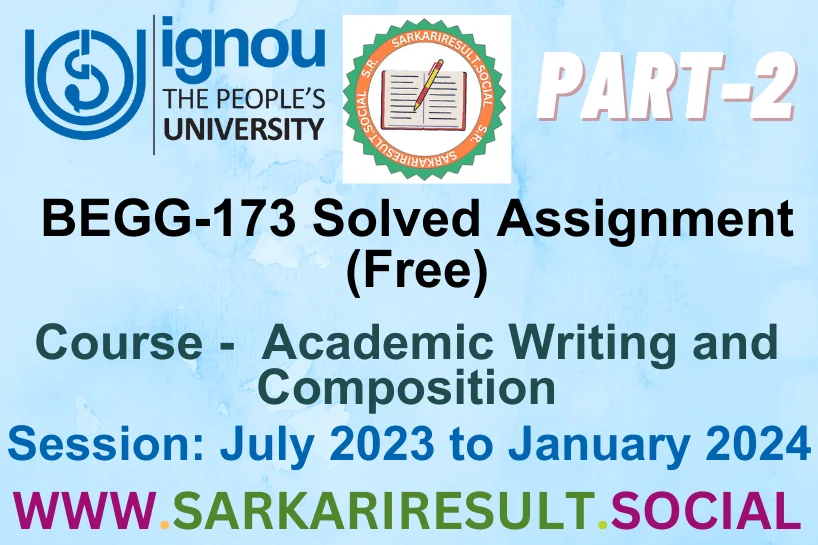BEGG 173 SOLVED IGNOU ASSIGNMENT FREE PART 2

Dive into Section B of Academic Writing and Composition BEGG 173 SOLVED IGNOU ASSIGNMENT FREE PART 2 with our detailed IGNOU Solved Assignments 2024. Explore the concept of ‘plagiarism’ and elucidate strategies for avoiding it in academic writing within approximately 200 words each. Identify the disciplines within the realm of natural and applied sciences, outlining the general features of academic writing in these fields in around 200 words for each discipline.
In addition, discuss the foundational elements of critical thinking skills, exploring techniques within approximately 250 words.

Q.2 Answer the following in around 200 words each:
1. What do you understand by the term ‘plagiarism’? How can you avoid plagiarism in your academic writing?
Ans. Plagiarism refers to the act of presenting someone else’s ideas, words, or work as one’s own without proper attribution. It is a breach of academic integrity, involving both intentional and unintentional use of others’ work without proper acknowledgment. Plagiarism undermines the principles of honesty and originality in academic and creative pursuits.
Avoiding plagiarism involves several key practices:
1. Citation and Referencing: Whenever you use someone else’s ideas, paraphrase, or directly quote, provide proper citations in the appropriate format (APA, MLA, Chicago, etc.).
2. Quotation Marks: When directly quoting, use quotation marks and cite the source. This indicates that the words are not your own.
3. Paraphrasing: If you rephrase someone else’s ideas, ensure that you still credit the original source through proper citation.
4. Reference Page: Include a comprehensive reference or bibliography page listing all the sources you used in your work.
5. Use of Plagiarism Detection Tools: Run your work through plagiarism detection tools to identify and rectify unintentional instances of plagiarism.
6. Understanding Academic Integrity Policies: Familiarize yourself with your institution’s policies on plagiarism to ensure compliance.
7. Time Management: Plan your time effectively to avoid rushed writing, which can lead to accidental plagiarism.
8. Developing Proper Note-Taking Practices: Keep detailed notes during research, including source information, to easily reference during the writing process.
By embracing these practices, writers can maintain academic integrity, acknowledge the contributions of others, and produce work that is truly their own.
2. Which are the disciplines that come under the stream of natural and applied sciences? Describe the general features of academic writing in these disciplines.
Ans. Natural and Applied Sciences encompass a diverse range of disciplines, including:
1. Physics: The study of matter, energy, and fundamental forces.
2. Chemistry: Examines the composition, structure, properties, and changes of matter.
3. Biology: Focuses on living organisms, their structure, function, growth, evolution, and distribution.
4. Geology: Explores the Earth’s structure, composition, and processes shaping its surface.
5. Environmental Science: Investigates the interaction between living organisms and their environment.
6. Computer Science: Studies algorithms, data structures, programming languages, and computing systems.
7. Mathematics: Involves the study of patterns, structures, and relationships.
General Features of Academic Writing in these Disciplines:
1. Precision: Clarity and precision are paramount. Scientific writing should convey ideas accurately without ambiguity.
2. Objectivity: Academic writing in these disciplines maintains an objective tone, avoiding personal biases or emotions.
3. Citations and References: Proper citation of sources is crucial. Academic integrity relies on acknowledging existing work.
4. Empirical Evidence: The use of empirical evidence, experiments, or data is common to support claims and hypotheses.
5. Logical Structure: Writing is organized with a clear introduction, methodology, results, discussion, and conclusion in research papers.
6. Technical Language: The use of specialized terminology is prevalent for accuracy and specificity.
7. Peer Review: Many works undergo peer review, ensuring the quality and validity of research.
8. Conciseness: Academic writing in these disciplines values clarity and brevity, presenting complex ideas succinctly.
9. APA/MLA/Chicago Style: Specific citation styles are often prescribed to maintain uniformity and facilitate referencing.
10. Abstracts and Summaries: Many scientific papers include abstracts, providing a concise overview of the study.
These features collectively contribute to the rigor, credibility, and communicative effectiveness of academic writing in natural and applied sciences.
Q.3 Answer the following question in about 250 words.
1. Discuss the techniques understood to be the foundational elements of critical thinking skills.
Ans. Critical thinking is a foundational skill that involves the ability to analyze, evaluate, and synthesize information to make informed decisions. Several techniques contribute to the development of critical thinking skills:
1. Analysis and Interpretation: Breaking down information into parts, examining relationships, and understanding the components of an argument or concept.
2. Inference: Drawing logical conclusions based on available information and evidence, even when it’s not explicitly stated.
3. Evaluation: Assessing the credibility, relevance, and validity of information and arguments, considering different perspectives.
4. Problem Solving: Identifying, defining, and solving problems systematically by employing logical and creative approaches.
5. Decision Making: Weighing options, considering consequences, and making well-informed decisions.
6. Creativity: Thinking outside conventional boundaries, generating innovative ideas, and exploring alternative solutions.
7. Reflection: Analyzing one’s thought processes, biases, and assumptions, fostering self-awareness and continuous improvement.
8. Effective Communication: Clearly expressing thoughts, ideas, and arguments in a structured and coherent manner, adapting communication to the audience.
9. Open-mindedness: Being receptive to diverse perspectives and ideas, avoiding rigid thinking or preconceived notions.
10. Curiosity: A desire to explore, learn, and seek information, fostering an inquisitive mindset.
11. Active Listening: Engaging fully in listening, processing, and comprehending others’ viewpoints before formulating a response.
12. Information Literacy: The ability to find, evaluate, and use information from various sources critically.
13. Metacognition: Thinking about one’s thinking process, understanding how personal biases and assumptions influence decisions.
14. Logical Reasoning: Applying sound reasoning and avoiding fallacies in arguments, ensuring the coherence of one’s thoughts.
These techniques collectively empower individuals to approach problems and decisions systematically, consider multiple perspectives, and make well-founded judgments. Critical thinking skills are not only crucial in academic settings but also in professional and personal spheres, fostering intellectual autonomy and adaptability in a rapidly changing world.
Also See This: BEGG 173 SOLVED IGNOU ASSIGNMENT FREE PART 3







